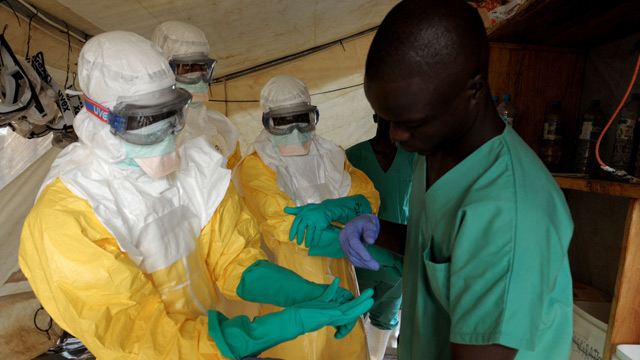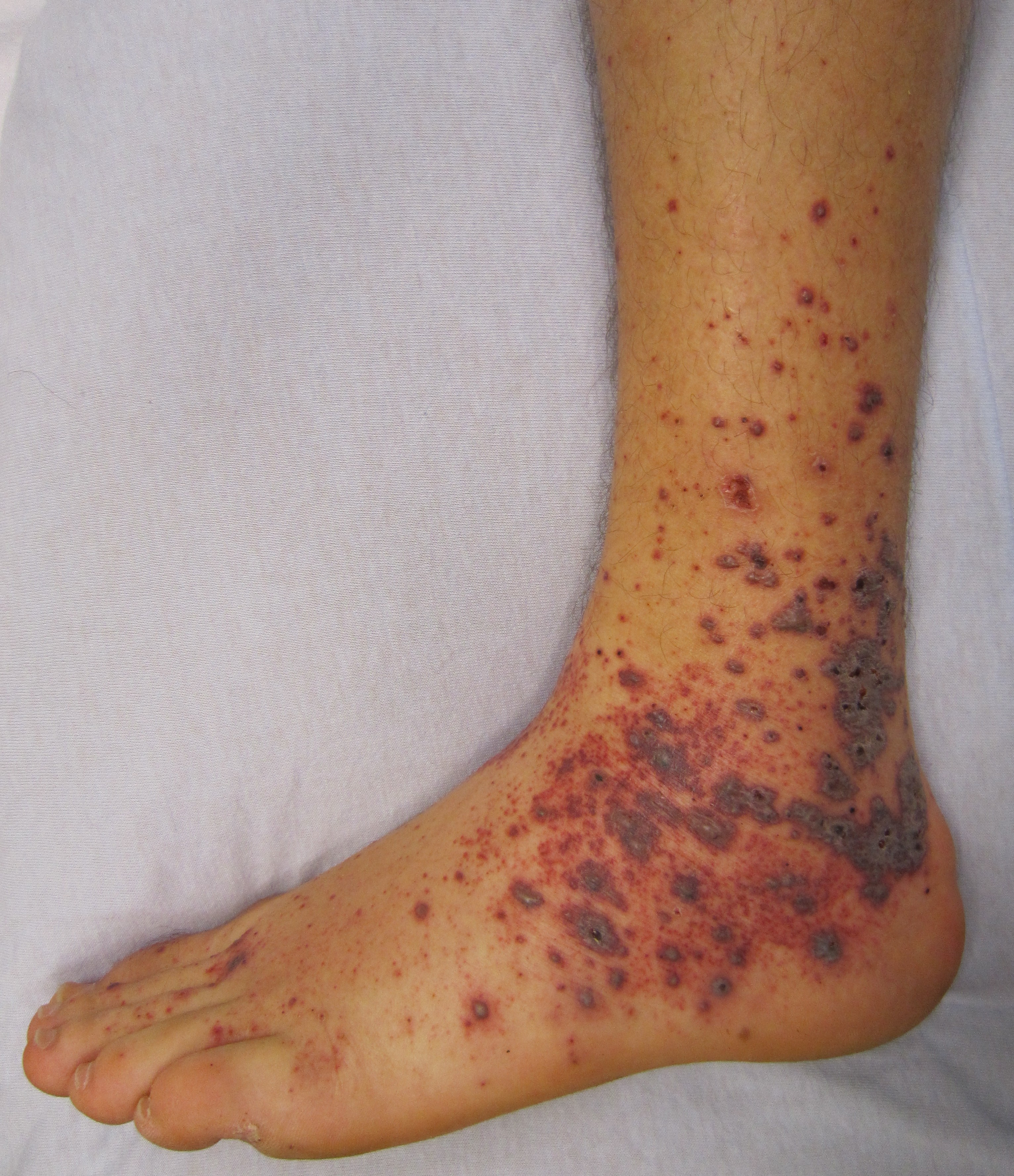Dear Dr. Deena,
I have heard so much about the Ebola virus in the news. What is it? How is it spread? What is hemorrhagic fever?
Thanks,
Dave
Thanks for the questions, Dave. Right now we are witnessing history as the Ebola virus has never been seen in the Western Hemisphere, let alone the USA!
The Ebola virus was discovered in the 1970s in Africa near the Ebola River (hence the name). No one really knows where the initial virus came from, but it is suspected to have originated amongst animals -- researchers have identified the source to be most likely monkeys or bats.
The first human infected with Ebola likely had some contact with the bodily secretions of an animal which was infected by the Ebola virus. The Ebola virus then spread from that infected human to another human by way of bodily secretions.
You may be wondering what exactly constitutes bodily secretions/fluids? Bodily secretions is a broad term for any liquid that comes from inside our body, and can include:
The Ebola virus is present in all bodily secretions, and in order for it to infect another individual it must enter into their body via any cut/opening in the skin or mucous membranes (which includes the eyes, nose, mouth, genital area, etc.). Once the virus enters into the body, it begins to replicate to make many more viruses. The higher the viral load (i.e. the number of Ebola viruses) that the infected person has, the larger the amount of viruses that are present in their bodily secretions -- making that patient highly infectious.
It might make sense now as to why there are so many precautions in place to safeguard the personnel caring for those with Ebola. Healthcare workers need to protect every aspect of their skin with gloves, face shields, masks, full body gowns from head-to-toe, etc.


If you have traveled to West Africa and have developed the symptoms noted above, you should be evaluated by a physician right away. Luckily a blood test can be performed to evaluate for this virus and there are some treatment options on the horizon.
Hope this information helps you better understand the Ebola virus, and why we are so fearful of this disease making its presence in the USA!
Please feel free to email your thoughts and questions to DoctorDeenaMD@gmail.com.
**PLEASE REMEMBER IF YOU HAVE ANY QUESTIONS OR CONCERNS ABOUT YOUR HEALTH AND/OR BEFORE STARTING OR STOPPING ANY TREATMENT OR ACTING UPON INFORMATION CONTAINED ON THE SITE, YOU SHOULD CONTACT YOUR OWN PHYSICIAN OR HEALTH-CARE PROVIDER**
I have heard so much about the Ebola virus in the news. What is it? How is it spread? What is hemorrhagic fever?
Thanks,
Dave
Thanks for the questions, Dave. Right now we are witnessing history as the Ebola virus has never been seen in the Western Hemisphere, let alone the USA!
The Ebola virus was discovered in the 1970s in Africa near the Ebola River (hence the name). No one really knows where the initial virus came from, but it is suspected to have originated amongst animals -- researchers have identified the source to be most likely monkeys or bats.
The first human infected with Ebola likely had some contact with the bodily secretions of an animal which was infected by the Ebola virus. The Ebola virus then spread from that infected human to another human by way of bodily secretions.
You may be wondering what exactly constitutes bodily secretions/fluids? Bodily secretions is a broad term for any liquid that comes from inside our body, and can include:
- blood
- feces
- urine
- semen
- mucous
- saliva
- vaginal secretions
The Ebola virus is present in all bodily secretions, and in order for it to infect another individual it must enter into their body via any cut/opening in the skin or mucous membranes (which includes the eyes, nose, mouth, genital area, etc.). Once the virus enters into the body, it begins to replicate to make many more viruses. The higher the viral load (i.e. the number of Ebola viruses) that the infected person has, the larger the amount of viruses that are present in their bodily secretions -- making that patient highly infectious.
It might make sense now as to why there are so many precautions in place to safeguard the personnel caring for those with Ebola. Healthcare workers need to protect every aspect of their skin with gloves, face shields, masks, full body gowns from head-to-toe, etc.

According to the CDC, the symptoms of Ebola occur 2 to 21 days after exposure to the Ebola virus though 8-10 days is most common.
Initial symptoms of the virus are pretty non-specific and include fever, muscle pains, headache, weakness, diarrhea, and/or stomach pain. These initial symptoms can be managed with supportive treatment to prevent dehydration and treat underlying pain and/or other symptoms.
When the virus replicates further, symptoms worsen and can lead to "hemorrhagic fever" which is one of the deadliest complications of this disease.
There are 5 families of viruses that cause hemorrhagic fever, and Ebola is a member of one of those virus families.
To better understand hemorrhagic fever -- let's go back to basic biology. Our body produces many proteins, known as clotting factors, which help form clots in our body to prevent bleeding. You may not be aware of it, but our blood vessels go through a small amount of damage every day -- whether its from bumping into a hard surface, brushing our teeth hard and causing minor gum bleeding, or getting a paper cut. Without clotting factors, any minor injury to our blood vessels can lead to an excessive loss of blood. Thus, a paper cut that should take 20 seconds to stop bleeding might take 2 minutes if the person's clotting factors are not working correctly.
When the virus replicates further, symptoms worsen and can lead to "hemorrhagic fever" which is one of the deadliest complications of this disease.
There are 5 families of viruses that cause hemorrhagic fever, and Ebola is a member of one of those virus families.
To better understand hemorrhagic fever -- let's go back to basic biology. Our body produces many proteins, known as clotting factors, which help form clots in our body to prevent bleeding. You may not be aware of it, but our blood vessels go through a small amount of damage every day -- whether its from bumping into a hard surface, brushing our teeth hard and causing minor gum bleeding, or getting a paper cut. Without clotting factors, any minor injury to our blood vessels can lead to an excessive loss of blood. Thus, a paper cut that should take 20 seconds to stop bleeding might take 2 minutes if the person's clotting factors are not working correctly.
The hemorrhagic fever viruses, like Ebola, cause 2 major problems. First -- the viruses cause blood vessels to become very leaky leading to blood seeping out of the vessels.
Secondly -- the viruses lead to a decrease in clotting factors. As you might have predicted -- the combination of these two circumstances is a recipe for an uncontrolled bleed...which is exactly what happens with hemorrhagic fever. Patients with hemorrhagic fever experience blood loss into different (or all) organs of the body.
One of the earliest signs of hemorrhagic fever is bleeding into the skin (the medical term is petechia or purpura) and looks like this (each red dot seen is blood underneath the skin):
(image courtesy of Google images)
Patients with hemorrhagic fever require intensive medical support to replace blood loss, maintain their blood pressure, and prevent organ failure. Mortality from Ebola virus in W. Africa is estimated at 60-70%, which is why it is so important to start supportive care/treatment early in the disease.
If you have traveled to West Africa and have developed the symptoms noted above, you should be evaluated by a physician right away. Luckily a blood test can be performed to evaluate for this virus and there are some treatment options on the horizon.
Hope this information helps you better understand the Ebola virus, and why we are so fearful of this disease making its presence in the USA!
Please feel free to email your thoughts and questions to DoctorDeenaMD@gmail.com.
**PLEASE REMEMBER IF YOU HAVE ANY QUESTIONS OR CONCERNS ABOUT YOUR HEALTH AND/OR BEFORE STARTING OR STOPPING ANY TREATMENT OR ACTING UPON INFORMATION CONTAINED ON THE SITE, YOU SHOULD CONTACT YOUR OWN PHYSICIAN OR HEALTH-CARE PROVIDER**